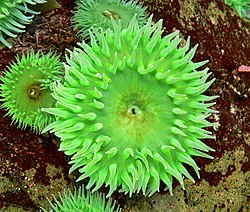| Zoochlorella | |
|---|---|
| Scientific classification (obsolete) | |
| Kingdom: | Plantae |
| Division: | Chlorophyta |
| Class: | Trebouxiophyceae |
| Order: | Chlorellales |
| Family: | Chlorellaceae |
| Genus: | Zoochlorella K.Brandt, 1881, nom. rejic. |
Zoochlorella (pl.: zoochlorellae) is a colloquial term for any green algae that lives symbiotically within the body of an aquatic invertebrate animal or a protozoan. [1]


